INTRODUCTION ABOUT PALMIERS
Palmiers are a popular French pastry cookie known for their delicate, flaky texture, and caramelized sugar coating. Also called elephant ears, palm hearts, and other names depending on the region, these cookies are a beloved treat enjoyed worldwide.
Palmiers are believed to have originated in the early 20th century in either Austria or France, potentially as a clever way for pastry chefs to use leftover puff pastry dough.
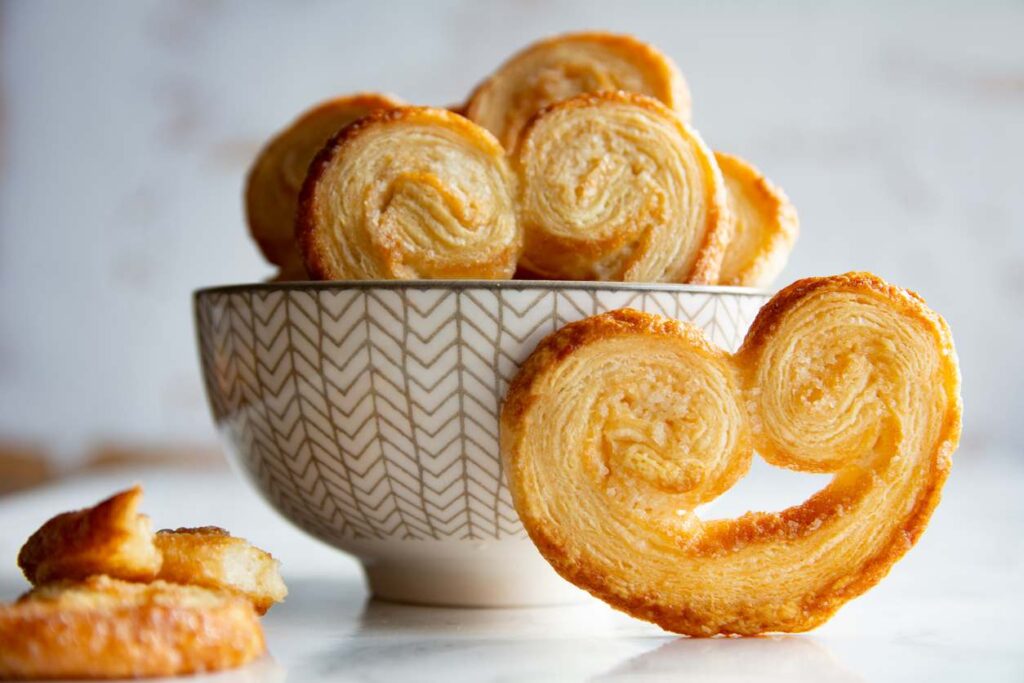
While the name is French for ” palm leaf” , referring to their shape, they are also known by names like ” elephant ears” (English speaking countries), “little ears” (Russia, Ukraine), and “butterfly pastries” (China).
Flavor and texture
- Palmiers offer a delightful combination of textures: they are crispy on the outside from the caramelized sugar and light and flaky on the inside due to the layered puff pastry.
- While the classic version features only sugar, many delicious variations exist, including cinnamon sugar, chocolate, and even savory versions using ingredients like Parmesan cheese, pesto, or herbs
Ingredients and Preparation
- Palmiers are surprisingly simple, requiring just two main ingredients: puff pastry and granulated sugar.
- The basic process involves rolling out the puff pastry, coating it generously with sugar, and then folding the dough in a specific way that creates the signature palm leaf or heart shape.
- The rolled and shaped dough is then chilled, sliced, and baked until the sugar caramelized and the pastry puffs up into numerous delicate layers.
- You can easily make palmiers at home using store bought puff pastry for a quick and simple treat.
Classic Palmiers Recipe
Ingredients Table
| Ingredient | Quantity |
|---|---|
| Puff pastry (store-bought or homemade) | 1 sheet (approx. 250g) |
| Granulated sugar | ½ cup (100g) |
| Unsalted butter (optional, melted) | 1 tbsp |
| Ground cinnamon (optional) | ½ tsp |
| Pinch of salt (optional) | Small pinch |
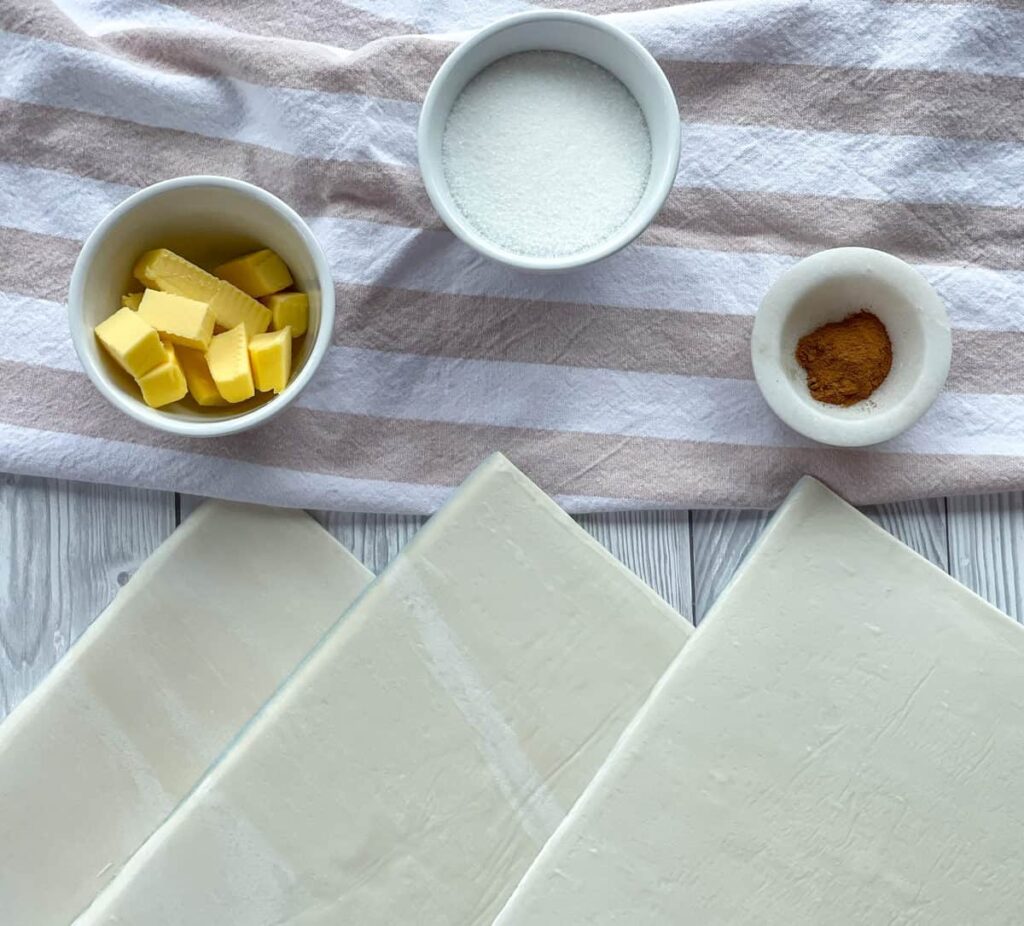
Instructions
Step 1: Preheat & Prep
- Preheat oven to 200°C (400°F).
- Line a baking sheet with parchment paper.
Step 2: Prepare the Sugar Mix
- Mix sugar with cinnamon and a pinch of salt (if using).
Step 3: Roll Out and Coat Pastry
- Lightly flour your surface.
- Sprinkle half of the sugar mix evenly on the surface.
- Place puff pastry sheet on top, then sprinkle the remaining sugar on top.
- Roll gently with a rolling pin to press sugar into the dough.
Step 4: Fold the Dough
- Fold the two longer sides of the pastry inward to meet in the center.
- Then fold both sides again toward the center.
- Finally, fold one side over the other — it should look like a log.
Step 5: Chill (Optional)
- Chill the folded log in the fridge for 15–20 minutes for cleaner cuts.
Step 6: Slice and Arrange
- Slice the log into ¼-inch (0.5–1 cm) thick pieces.
- Place slices cut-side up on the prepared baking sheet, spacing them well.
Step 7: Bake
- Bake for 12–15 minutes, flip each palmier, and bake for another 3–5 minutes until golden and caramelized.
Step 8: Cool and Serve
- Let them cool on a wire rack. They’ll crisp up as they cool.
- Enjoy your buttery, caramelized palmiers with tea or coffee!
Serving suggestions
- Palmiers are a versatile treat that can be enjoyed with coffee or tea, paired with ice cream, or even used as a base for savory canapés.
- They are often enjoyed as a snack, for breakfast, or as a dessert.
In essence, palmiers are a charming and delicious example of how simple ingredients and clever techniques can create a truly remarkable pastry
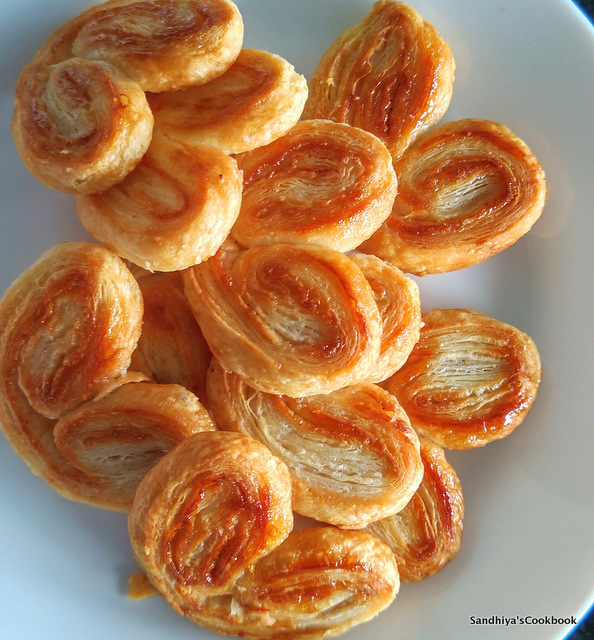
Conclusion:
Palmiers are a delightful example of how simple ingredients—puff pastry and sugar—can create an elegant and irresistibly crisp pastry. Whether served as a light snack, a sweet addition to tea time, or a festive treat, these classic French cookies bring a perfect balance of caramelized sweetness and buttery flakiness. Easy to make yet sophisticated in appearance, palmiers are a timeless indulgence that never goes out of style.
Nutritional Highlights of Palmiers (Per 1 medium cookie, approx. 20–25g):
| Nutrient | Approx. Value |
|---|---|
| Calories | 100–130 kcal |
| Carbohydrates | 12–15 g |
| Sugars | 6–8 g |
| Fat | 6–8 g |
| Saturated Fat | 2–4 g |
| Protein | 1–2 g |
| Fiber | 0.3–0.5 g |
Potential Nutritional Benefits:
- Quick Energy Boost
- The sugar and refined carbohydrates provide a fast source of energy, useful as a pre-workout snack or for an energy pick-me-up.
- Mood Uplifter
- The combination of sugar and carbs can stimulate serotonin production, temporarily boosting mood.
- Low in Sodium
- Compared to many other processed snacks, palmiers are typically low in salt unless modified.
Things to Watch:
- High in Sugar & Saturated Fat: Traditional palmiers use a lot of butter and sugar, which can contribute to weight gain, heart disease, and blood sugar spikes when consumed in excess.
- Low in Nutrients: They don’t provide significant amounts of vitamins, minerals, or fiber.
Tip for a Healthier Palmier:
- Use whole wheat puff pastry or reduced-sugar versions.
- Add cinnamon or crushed nuts for extra antioxidants and protein.
Would you like a comparison to other pastries or a healthier recipe version?
Variations of palmiers
Sweet Variations
- Classic Sugar Palmiers
- Puff pastry + granulated sugar
- Lightly caramelized and crisp.
- Cinnamon Sugar Palmiers
- Puff pastry + cinnamon + sugar
- Warm, spiced flavor—perfect for fall.
- Chocolate Palmiers
- Spread with melted chocolate or Nutella before folding
- Rich and indulgent.
- Vanilla or Orange Zest Sugar Palmiers
- Add citrus zest or vanilla sugar for extra aroma.
- Honey Almond Palmiers
- Brushed with honey and sprinkled with sliced almonds.
- Jam-Filled Palmiers
- A thin layer of raspberry, apricot, or strawberry jam inside
- Fruity and chewy inside, crispy outside.
- Coconut Sugar Palmiers
- Mix shredded coconut with sugar
- Adds texture and tropical flavor.
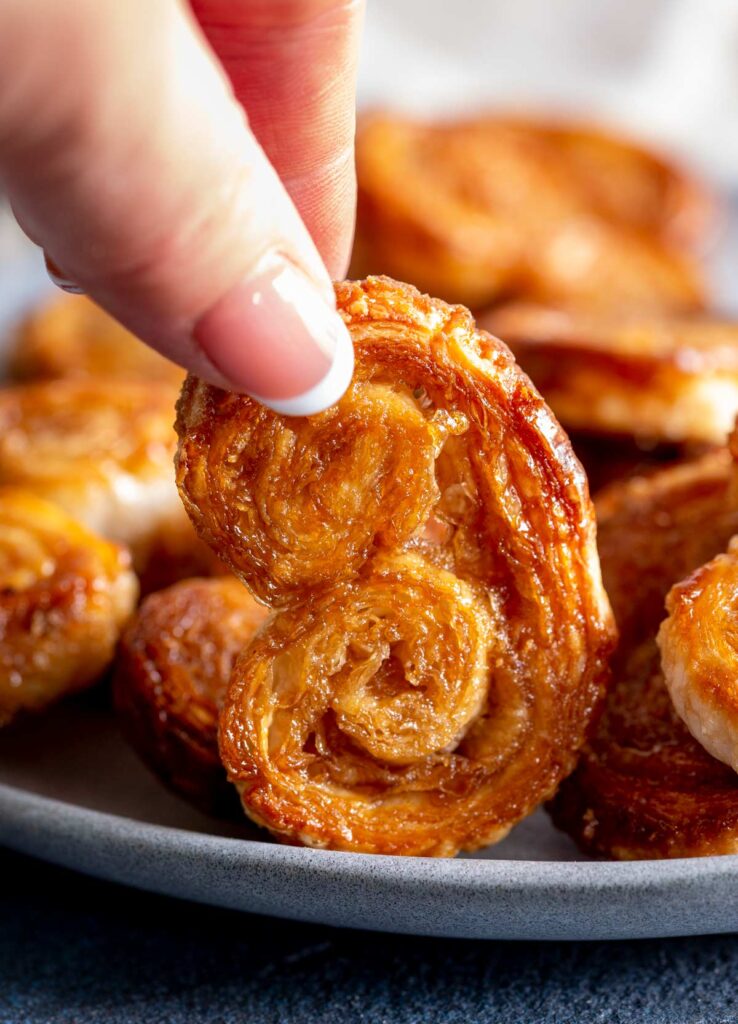
Savory Variations
- Cheese Palmiers
- Parmesan, cheddar, or gruyère inside
- Great as appetizers or snacks.
- Pesto Palmiers
- Layer of basil pesto for a herbaceous, nutty bite.
- Tapenade Palmiers
- Spread with olive tapenade (black or green)
- Perfect Mediterranean flavor.
- Ham & Cheese Palmiers
- Thin slices of ham and grated cheese
- Great for brunch or parties.
- Sun-Dried Tomato & Goat Cheese Palmiers
- Tangy and savory, ideal for gourmet palates.
- Spinach & Feta Palmiers
- A Greek-inspired filling, lightly seasoned.
Tips for perfect palmiers
Dough Handling Tips
- Use well-chilled puff pastry: Keep it cold to prevent sticking and ensure crisp, flaky layers.
- Work quickly: Puff pastry softens fast at room temperature; if it gets too warm, chill it again before shaping.
Sugar Coating Tips
- Use granulated sugar generously: It helps caramelize the outer layers. Sprinkle it under and over the dough.
- Flip and press: Roll the dough with sugar on both sides to help it stick and melt beautifully while baking.
Folding Technique
- Accurate shaping: Fold each long edge halfway to the center, then fold again like a book (or shape into a heart). Chill before slicing for clean cuts.
- Even thickness: Keep rolls tight and consistent for uniform baking and shape.
Cutting & Spacing
- Slice evenly (¼ inch thick): Uneven pieces bake inconsistently. A sharp knife avoids squashing.
- Leave space on the tray: Palmiers puff up and spread. Don’t overcrowd!
Baking Tips
- Use parchment or silicone mat: Sugar melts—protect your tray and avoid sticking.
- Preheat the oven fully (200°C/400°F): A hot oven ensures rapid puffing and caramelization.
- Flip halfway (optional): For extra caramelization on both sides, flip them gently with a spatula halfway through baking.
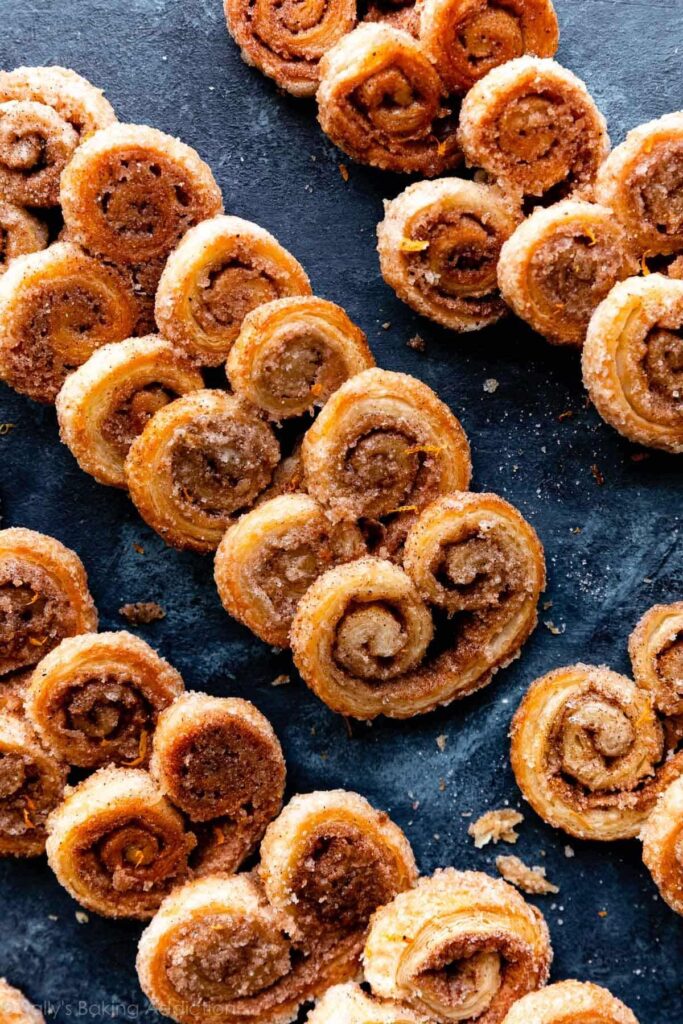
Cooling & Storage
- Cool on a rack: They crisp up as they cool.
- Store airtight: Keeps them crisp for a few days. Avoid humid environments.


